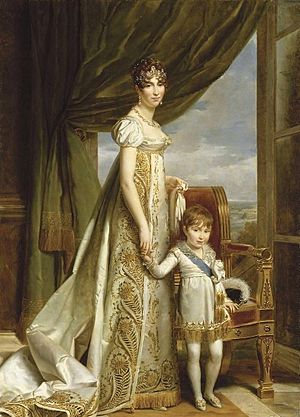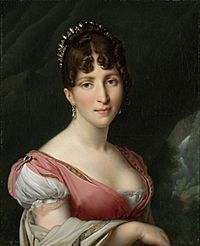Hortense de Beauharnais facts for kids
Quick facts for kids Hortense de Beauharnais |
|
|---|---|
| Duchess of Saint-Leu | |

Queen Hortense with her second son, Prince Napoléon Louis. Portrait by François Gérard, 1807
|
|
| Queen consort of Holland | |
| Tenure | 5 June 1806 – 1 July 1810 |
| Born | 10 April 1783 Paris, France |
| Died | 5 October 1837 (aged 54) Arenenberg, Thurgau, Switzerland |
| Burial | St Pierre-St Paul Church, Rueil-Malmaison, France |
| Spouse | |
| Issue |
|
| House | Beauharnais |
| Father | Alexandre de Beauharnais |
| Mother | Joséphine Tascher de la Pagerie |
| Religion | Roman Catholicism |
| Royal styles of Queen Hortense of Holland |
|
|---|---|
 |
|
| Reference style | Her Majesty |
| Spoken style | Your Majesty |
Hortense Eugénie Cécile Bonaparte ( née de Beauharnais 10 April 1783 – 5 October 1837) was Queen consort of Holland. She was the stepdaughter of Emperor Napoléon I as the daughter of his first wife, Joséphine de Beauharnais. Hortense later married Napoléon I’s brother, Louis Bonaparte, who had been made King of Holland, making her the sister-in-law to her step-father. She was the mother of Napoléon III, Emperor of the French; Louis II of Holland; and Napoléon Louis Charles Bonaparte who died at the age of four. She had also an illegitimate son, Charles, Duke of Morny, by her lover, the Comte de Flahaut.
Early life
Hortense Eugénie Cécile Bonaparte was born in Paris, France, on 10 April 1783. She was born as the second child and first daughter to Alexandre François Marie, Vicomte de Beauharnais, and Joséphine Tascher de la Pagerie. Her parents separated when she was five years old, and between the ages of five and ten, she was sent to live in Martinique. Her father was executed on 23 July 1794, at the time of the French Revolution, a few days before the end of the Reign of Terror. Her mother was imprisoned in the Carmelites prison, from which she was released on 6 August 1794, due to the intervention of her friend Thérèse Tallien. Two years later, her mother married Napoléon Bonaparte.
Hortense was described as having been an amusing and pretty child with long, pale golden-blonde hair and blue eyes. She received her education at the school of Madame Jeanne Campan in St-Germain-en-Laye together with Napoléon's youngest sister Caroline Bonaparte, who later married Joachim Murat. She was sent to boarding school when her mother, Josephine, decided that she did not have enough time to raise children. There, she developed a love for fine art and music. Hortense was an accomplished amateur musical composer and supplied the army of her stepfather with rousing marches, including Partant pour la Syrie. She also enjoyed playing games and particularly excelled at billiards.
In 1802, at Napoléon's request, Hortense married his brother Louis Bonaparte. Hortense was reluctant to marry at first, but her mother persuaded her to accept for the political wellbeing and prosperity of the family.
Queen of Holland
In 1806 Napoléon appointed his brother Louis as King of Holland, and Hortense accompanied her husband to The Hague. Hortense's negativity towards being appointed Queen of Holland was twofold. First, it was necessary for her to move there with Louis, with whom she did not get along, and second, she had to leave her life as a celebrated member of Parisian society.[3] She had hoped to be "a Queen of Holland in Paris", but Napoléon did not agree. She was eventually forced to depart with Louis to the Netherlands, where she arrived on 18 June 1806.
Queen Hortense was pleasantly surprised when the Dutch public welcomed her warmly. She quickly became accustomed to life in the Netherlands and came to like the country. She attended official celebrations and ceremonies, visited the market-places where she made large purchases, and was much liked by the public, which annoyed her husband. She learned water-colour painting and made trips around the countryside. Nevertheless, she hated her stay there because of her relationship with King Louis. The couple lived in different parts of the palace and avoided each other at every opportunity, with Hortense describing herself as a prisoner. She also refused to give up her French citizenship and declare herself Dutch as Louis had done.
In 1807 her first son died; she was subsequently allowed to stay in France, as the climate there was considered better for raising her other son Louis-Napoléon. She remained in France, again pleased by her status as a queen at the French court, until 1810, when Napoléon remarried to Marie Louise of Austria.
This forced Hortense return to the Netherlands and reconcile with her husband. When Napoleon married Marie Louise, Hortense returned temporarily to the Netherlands, but found that the Dutch did not welcome her. She considered this the end of her marriage, and left for France shortly before her husband abdicated the throne to their oldest living son, Napoleon-Louis Bonaparte, making him Louis II of Holland.
Personal life
Hortense was now free to respond to the romantic overtures of the man whom she had long admired, Colonel Charles Joseph, Comte de Flahaut, a sophisticated, handsome man rumoured to be the illegitimate son of Talleyrand. They soon became lovers. In 1811, at an unspecified inn in Switzerland, close to Lake Geneva, Hortense secretly gave birth to a son by de Flahaut, Charles Auguste Louis Joseph ( 21 October 1811 - 10 March 1865), created Duke of Morny by his half-brother, Napoléon III, in 1862.
Only her brother Eugène, her closest companions, and Adélaïde Filleul de Souza (Charles de Flahaut's mother) were aware of her pregnancy and the subsequent birth. She had used poor health to explain her prolonged visit to Switzerland, the journey having been arranged by Adélaïde. Hortense cleverly disguised her pregnancy (she was, by then, in her sixth month) during the baptism of Napoléon's son, Napoléon II, when she was chosen to be one of the child's godmothers, an honour she shared with Madame Mère, mother of the Emperor.
In 1814 Flahaut became romantically involved with the Comédie-Française actress Mademoiselle Mars. In October that year she went on a pilgrimage to the Benedictine shrine of Our Lady of the Hermits at Einsiedeln Abbey in the Swiss canton of Schwyz. After renouncing her claims on Charles, she presented a bouquet of diamond hydrangeas to the Virgin and a ring for the abbot, having been blessed, she wrote, with "so many consolations, such happiness at Einsiedeln not to wish that my memory remain there after I had left."
Composer
Hortense de Beauharnais found love for music during her time in boarding school and there she became a self-acclaimed amateur composer (Beaucour, 2007). Though she did not have any known education in composition, it is said that she was a very talented singer and pianist. Fétis wrote about her in his article, Biographie Universelle des Musiciens, the following lines:
- “Plantade was Queen Hortense’s singing-master when she was at Mad. Campan’s school; what her Majesty gained more especially from her lessons was a great capability of stint, she composed several pieces of this kind, among which is the one beginning with the words: ‘Partant pour la Syrie.’ This romance, which enjoyed a great vogue about 1810, again became popular in France after 1852.” While her step-father, Napoleon, ruled over France, she wrote marches and some of her songs were sung by the French Troops.
Hortense was banished when Napoleon was defeated and there she wrote numerous pieces, mostly notably her 12 Romances she wrote for her brother Eugene. Although she was banished, Hortense’s home exemplified the spirit of French art culture. There she presented her arts for her many visitors. Famous artists of the time such as Franz Liszt, Alexandre Dumas, and Lord Byron came to visit and listened to her piano performances. Hortense’s most famous composition ‘Partant pour la Syrie’ became the national hymn of France after her son Emperor Napoleon III instated it as such. (Last FM, 2010). French composer Camille Saint-Saens quotes “Partant pour la Syrie” in “Fossils” from his Carnival of the Animals.
A collection of some of her writing, art, and compositions can be found in her “Livre d’art de la reine Hortense.”
Charities
Hortense is known for her many donations to the poor, and was also known to be a favourite amongst them. She states in her memoirs, “Going to one of the mulatto houseservants I announced, ‘John, look at all this money granny gave me for the poor black people. Take me round to their cabins so I can give it to them.’”
Later years
At the Bourbon Restoration in 1814, Hortense received the protection of Alexander I of Russia. At his instigation, she was granted the title of Duchess of Saint-Leu (duchesse de Saint-Leu) by King Louis XVIII on 30 May 1814. During the Hundred Days, however, Hortense supported her stepfather and brother-in-law Napoléon. This led to her banishment from France after his final defeat.
During her banishment, Hortense began to focus on writing her memoirs, composing and publishing her musical works, as well as drawing and painting. Her home became a center for French art and culture. Established artists, composers, and writers were all fascinated by the banished queen in Switzerland.
Despite her residence in Switzerland, Hortense remained involved in her sons’ lives. When one of her sons, Napoleon-Louis (Louis II of Holland), died in the Italian revolt against Austrian rule, she helped the other, Charles-Louis Napoleon, escape to Paris.
She traveled in Germany and Italy before purchasing the Château Arenenberg in the Swiss canton of Thurgau in 1817. She lived there until she died of cancer on 5 October 1837, at the age of fifty-four. She is buried next to her mother Joséphine in the Saint-Pierre-Saint-Paul church in Rueil-Malmaison. After her death, her remaining legitimate son Charles-Louis Napoleon returned to Paris where he became Emperor Napoleon III. With his newly instated power, Napoleon III made one of his mother’s most popular compositions, “Partant pour la Syrie” a national hymn of France.
A portrait of Hortense hangs at James Monroe’s Highland, the Virginia plantation home of James Monroe, fifth President of the United States. It was one of three portraits given by Hortense to Monroe's daughter Eliza, who went to school with Hortense in France. (The other two portraits are of Hortense's brother Eugène de Beauharnais and of Jeanne-Louise-Henriette Campan, the headmistress of the school attended by Hortense and Eliza.) Eliza's daughter, Hortensia Monroe Hay, was named in honour of Hortense.
Issue
With Louis Bonaparte she had three sons:
- Napoléon Louis Charles Bonaparte (10 October 1802 - 5 May 1807) died at the age of four years old.
- Napoléon Louis Bonaparte (11 October 1804 - 17 March 1831) he married Charlotte Napoléone Bonaparte on 23 July 1826.
- Charles-Louis Napoléon Bonaparte, later Napoleon III (20 April 1808 - 9 January 1873) he married Eugénie de Palafox, Countess of Montijo on 29 January 1853. They had one son.
With Charles Joseph, Comte de Flahaut, she had one son:
- Charles Auguste Louis Joseph (21 October 1811 - 10 March 1865), created Duke of Morny by his half-brother, Napoléon III, in 1862.
See also
 In Spanish: Hortensia de Beauharnais para niños
In Spanish: Hortensia de Beauharnais para niños



